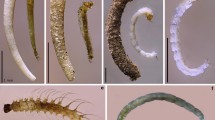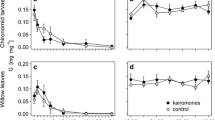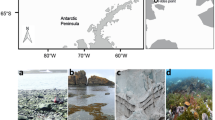Abstract
Only five of the 14 species of solitary ascidians in the San Juan Islands, Washington, USA commonly co-occur with an abundant predator of the rocky subtidal, the gastropod Fusitriton oregonensis. None of the common subtidal species is defended by vanadium or sulfuric acid; concentrations of these substances are highest in species that are eaten readily by F. oregonensis and are uncommon in the rocky subtidal. Experimental manipulations indicate that Halocynthia igaboja are protected by stiff spines of the tunic. The defense mechanism of Pyura haustor consists of a tough, leathery tunic with inorganic inclusions, and microscopic spines around the siphons. Boltenia villosa and Styela gibbsii are eaten by snails in the laboratory, but live in areas where the predator is abundant. Both find refuge as epizooites on P. haustor and H. igaboja. The mechanisms by which Cnemidocarpa finmarkiensis persists in the presence of F. oregonensis is unknown.
Similar content being viewed by others
Literature cited
Alexander, R. M.: Animal mechanics, 346 pp. London: Sidgwick and Jackson 1968
Bakus, G. J.: The effects of fish grazing on invertebrate evolution in shallow tropical waters. Allan Hancock Foundation Occ. Pap. 27, 1–29 (1964)
Bakus, G. J. and G. Green: Toxicity in sponges and holothurians: a geographic pattern. Science, Wash. DC 185, 951–953 (1974)
Birkeland, C., P. K. Dayton and N. A. Engstrom: A stable system of predation on a holothurian by four asteroids and their top predator. Aust. Mus. Mem. 16, 175–189 (1982)
Branch, G. M.: Aggression by limpets against invertebrate predators. Anim. Behav. 27, 408–410 (1979)
Bullock, T. H.: Predator recognition and escape responses of some intertidal gastropods in the presence of starfish. Behaviour 5, 130–140 (1953)
Buss, L. W.: Habitat selection, directional growth, and spatial refuges: why colonial animals have more hiding places, pp 459–497. In: Biology and systematics of colonial organisms. Ed. by G. Larwood and B. R. Rosen. New York and London: Academic Press 1979
Danskin, G. P.: Accumulation of heavy metals by some solitary tunicates. Can. J. Zool. 56, 547–551 (1978)
Dethier, M. N.: Tidepools as refuges: predation and the limits of the harpacticoid copepod Tigriopus californicus (Baker). J. exp. mar. Biol. Ecol. 42, 99–111 (1980)
Duggins, D. O.: Sea otters and kelp: an experimental approach. Ecology 61, 447–453 (1980)
Eaton, C. M.: The reproductive and feeding biology of the prosobranch gastropod, Fusitriton oregonensis (Redfield) (Fam. Cymatiidae), 40 pp. M.S. thesis, University of Washington, Seattle 1972
Endean, R.: Studies of the blood and test of some Australian ascidians II. The test of Pyura stolonifera (Heller). Aust. J. mar. freshwat. Res. 6, 139–164 (1955)
Feder, H. M.: Gastropod defensive responses and their effectiveness in reducing predation by starfishes. Ecology 44, 505–512 (1963)
Feder, H. M.: Organisms responsive to predatory seastars. Sarsia 29, 371–394 (1967)
Fox, L. R.: Defense and dynamics in plant-herbivore systems. Am. Zool. 21, 853–864 (1981)
Garten, R. P. H.: PIXE: Possibilities in elemental micro- and trace-analysis. TRAC, Trends Anal. Chem. 3, 152–157 (1984)
Ghiselin, M. T.: Morphological and behavioral concealing adaptations of Lamellaria stearnsii, a marine prosobranch gastropod. Veliger 6, 123–124 (1964)
Gibbons, J. D.: Nonparametric methods for quantitative analysis, 463 pp. New York: Holt, Rinehart and Winston 1976
Goldberg, E. D., W. McBlair and K. M. Taylor: The uptake of vanadium by tunicates. Biol. Bull. mar. biol. Lab., Woods Hole 101, 84–94 (1951)
Goodbody, I.: The physiology of ascidians. Adv. mar. Biol. 12, 1–149 (1974)
Green, G.: Ecology of toxicity in marine sponges. Mar. Biol. 40, 207–216 (1977)
Hawkins, C. J., P. Kott, D. L. Parry and J. H. Swinehart: Vanadium content and oxidation state related to ascidian phylogeny. Comp. Biochem. Physiol. 76 B, 555–558 (1983a)
Hawkins, C. J., G. A. James, D. L. Parry, J. H. Swinehart and A. L. Wood: Intracellular acidity in the ascidian. Comp. Biochem. Physiol. 76 B, 559–565 (1983b)
Jackson, J. B. C.: Biological determinants of present and past sessile animal distributions, pp 39–120. In: Biotic interactions in recent and fossil benthic communities. Ed. by M. J. S. Tevesz and P. L. McCail. New York: Plenum 1983
Kitching, J. A. and F. J. Ebling: Ecological studies at Lough Ine. Adv. ecol. Res. 4, 197–289 (1967)
Kott, P. L.: A review of the genus Halocynthia Verrill, 1879. Proc. Linn. Soc. N. S. W. 93, 76–89 (1968)
Lambert, G.: Early post-metamorphic growth, budding and spicule formation in the compound ascidian cystodytes lobatus. Biol. Bull. mar. biol. Lab., Woods Hole 157, 464–477 (1979)
Lambert, G.: Predation by the prosobranch mollusk Lamellaria diegoensis on Cystodytes lobatus, a colonial ascidian. Veliger 22, 340–344 (1980)
Lambert, G., C. C. Lambert and D. P. Abbott: Corella species in the American pacific northwest: distinction of C. inflata Huntsman, 1912 from C. willmeriana Herdman, 1898 (Ascidiacea, Phlebobranchia). Can. J. Zool. 59, 1493–1504 (1981)
Mackie, A. M. and P. T. Grant: Interspecies and intraspecies chemoreception by marine invertebrates, pp 105–141. In: Chemoreception in marine organisms. Ed. by P. T. Grant and A. M. Mackie. New York and London: Academic Press 1974
Mann, K. H.: Kelp, sea urchins and predators: a review of strong interactions in rocky subtidal systems of eastern Canada, 1970–1980. Neth. J. Sea Res. 16, 414–432 (1982)
Margolin, A. S.: A running response of Acmaea to seastars. Ecology 45, 191–193 (1964)
Maynard Smith, J.: Mathematical ideas in biology. New York and London: Cambridge University Press 1964
Murdoch, W. W. and A. Oaten: Predation and population stability. Adv. ecol. Res. 9, 1–131 (1975)
Nance, J. M. and L. F. Braithwaite: The function of mucous secretions in the cushion star Pteraster tesselatus Ives. J. exp. mar. Biol. Ecol. 40, 259–266 (1979)
Nelson, B. V. and R. R. Vance: Diel foraging patterns of the sea urchin, Centrostephanus coronatus, as a predator avoidance strategy. Mar. Biol. 51, 251–258 (1979)
Nielson, C.: Observations on Buccinum undataum L. attacking bivalves and on prey respons, with a short review on attack methods of other prosobranchs. Ophelia 13, 87–108 (1975)
Paine, R. T.: Intertidal community structure. Experimental studies on the relationship between a dominant competitor and its principal predator. Oecologia 15, 92–120 (1974)
Parry, D. L.: Chemical properties of the test of ascidians in relation to predation. Mar. Ecol. Prog. Ser. 17, 279–282 (1984)
Phillips, D. W.: The effect of species-specific avoidance response to a predatory starfish on the intertidal distribution of two gastropods. Occologia 23, 83–94 (1976)
Porter, J. W.: Predation by Acanthaster and its effect on coral species diversity. Am. Nat. 106, 487–492 (1972)
Rosenzweig, M. L. and R. H. MacArthur: Graphical representation and stability conditions of predator-prey interactions. Am. Nat. 97, 209–223 (1963)
Ross, D. M.: Behavior patterns in associations and interactions with other animals, pp 281–312. In: Coelenterate biology reviews and new perspectives. Ed. by L. Muscatine and H. M. Lenhoff. New York and London: Academic Press 1974
Ross, D. M. and L. Sutton: Swimming sea anemones of Puget Sound: swimming of Actinostola new species in response to Stomphia coccinea. Science, Wash. DC 155, 1419–1421 (1967)
Schmitt, R. J.: Consequences of dissimilar defenses against predation in a subtidal marine community. Ecology 63, 1588–1601 (1982)
Smith, M. J.: The blood cells and tunic of the ascidian Halocynthia aurantium (Pallas). I. hematology, tunic morphology, and partition of cells between blood and tunic. Biol. Bull. mar. biol. Lab., Woods Hole 138, 354–378 (1970)
Smith, J. T.: Taxonomy, distribution and phylogeny of the cymatiid gastropods Argobuccinum, Fusitriton, Mediargo and Priene. Bull. Am. Paleont. 56, 439–555 (1970)
Stoecker, D.: Resistance of a tunicate to fouling. Biol. Bull. mar. biol. Lab., Woods Hole 155, 615–626 (1978)
Stoecker, D.: Relationship between chemical defense and ecology in benthic ascidians. Mar. Ecol. Prog. Ser. 3, 257–265 (1980a)
Stoecker, D.: Chemical defenses of ascidians against predators. Ecology 61, 1327–1334 (1980b)
Strong, D. R., J. H. Lawton and R. Southwood: Insects on plants. Community patterns and mechanisms, 313 pp. Oxford and London: Blackwell 1984
Swinehart, J. H., W. R. Biggs, D. J. Halko and N. D. Schroeder: The vanadium and selected metal contents of some ascidians. Biol. Bull. mar. biol. Lab., Woods Hole 146, 302–312 (1974)
Thompson, T. E.: Defensive acid secretion in marine gastropods. J. mar. Biol. Ass UK 39, 115–122 (1960)
Thompson, T. E.: Protective resemblances in British Lamellaria. J. Conchol. 28, 75–78 (1973)
Vance, R. R.: A mutualistic interaction between a sessile marine clam and its epibionts. Ecology 59, 679–685 (1978)
Wardrop, A. B.: The structure and formation of the test of Pyura stolonifera. Protoplasma 70, 73–86 (1970)
Webb, D. A.: The blood of tunicates and the biochemistry of vanadium. Pubbl. St. Zool. Napoli 28, 273–288 (1956)
Wells, R. A.: Activity pattern as a mechanism of predator avoidance in two species of acmaeid limpet. J. exp. mar. Biol. Ecol. 48, 151–168 (1980)
Woodin, S. A.: Refuges, disturbance and community structure: a marine soft-sediment example. Ecology 59, 274–284 (1978)
Young, C. M.: Larval behavior, predation and early post-settling mortality as determinants of spatial distribution in subtidal solitary ascidians of the San Juan Islands, Washington, 260 pp. Ph.D. dissertation, University of Alberta, 1982
Young, C. M.: Abundance patterns of subtidal solitary ascidians in the San Juan Islands, Washington, as influenced by food preferences of the predatory snail Fusitriton oregonensis. Mar. Biol. 84, 309–321 (1985)
Young, C. M. and F. S. Chia: Factors controlling spatial distribution of the sea cucumber Psolus chitonoides: settling and post-settling behavior. Mar. Biol. 69, 195–205 (1982)
Young, C. M. and F. S. Chia: Microhabitat-associated variability in survival and growth of juvenile solitary ascidians during the first 21 days after settlement. Mar. Biol. 81, 61–68 (1984)
Author information
Authors and Affiliations
Additional information
Communicated by J. M. Lawrence, Tampa
Rights and permissions
About this article
Cite this article
Young, C.M. Defenses and refuges: alternative mechanisms of coexistence between a predatory gastropod and its ascidian prey. Marine Biology 91, 513–522 (1986). https://doi.org/10.1007/BF00392603
Accepted:
Issue Date:
DOI: https://doi.org/10.1007/BF00392603




